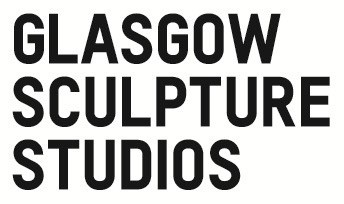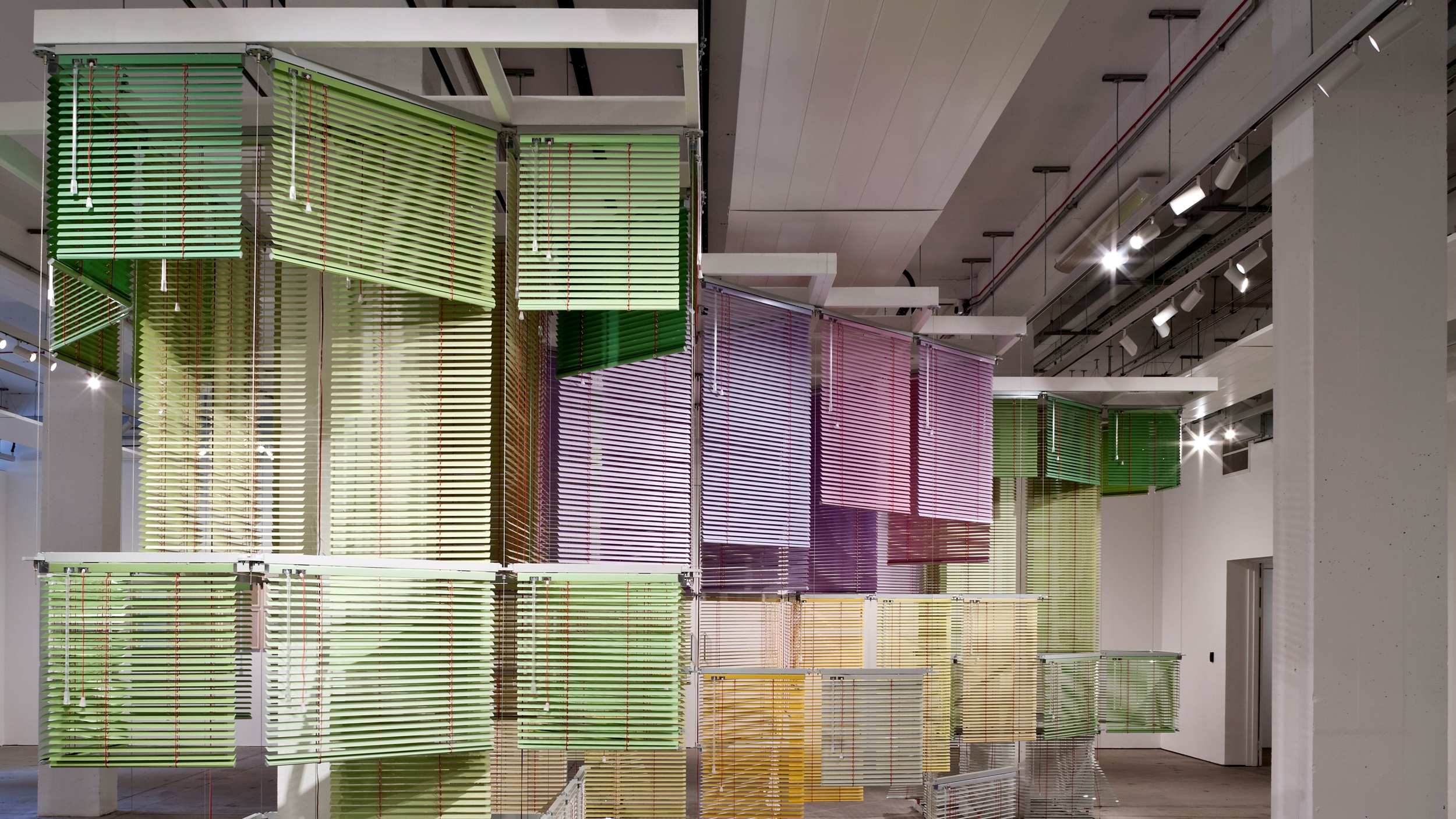haegue yang
JOURNAL OF BOUBA/KIKI
5 October – 20 December 2013
Glasgow Sculpture Studios presented an exhibition of new work, Journal of Bouba/kiki, by Korean artist Haegue Yang, borne out of a three-month production residency that the artist undertook at GSS from June until September 2013. This residency provided Yang with space for research, development and the production of new work. The exhibition was the first time that her work had been shown in Scotland.
The artist’s long-standing interests in the economy of labour, fabrication, movement, handicraft and abstraction had a continued presence in the exhibition. Examining what ‘production’ means in terms of an artist’s practice today, Yang brought together a variety of working methods. Her works ranged from complex installations using high-end fabrication with industrially produced and commercially available products, to hand-made sculptures and objects using traditional handicraft techniques. The handicraft pieces made from craft techniques such as knitting, paper making, origami and macramé are typically considered to be amateur, quotidian and less labour intensive, when compared to the conceptual and technologically advanced processes involved with her larger installations. This apparent opposition could be read as dialectic however, Yang sees them as a complementary combination. Yang is an artist that continuously pushes the boundaries of her practice engaging with new methodologies and ways of making. Using the idea of a ‘production’ residency as a challenge to her own efficiency, where she is away from her usual safe environment of the studio, the artist embraced GSS’ extensive range of processes and facilities for working to create an exciting and dynamic new body of work.
The exhibition brought together four new projects by Yang, developed entirely at GSS, with one pre-existing work that was produced during another production residency undertaken by the artist at Singapore Tyler Print Institute (STPI), Singapore in November 2012. A major new venetian blind installation, Three Folds and Multiple Twists 2013, formed the central part of her presentation. Yang’s interest in blinds stem in part from their limited function – they are made to simply conceal and to reveal – and yet she continually finds new ways to experiment with their configuration. In this installation a number of the lower blinds subtly twisted in accordance with a choreographed programme. This presented a sensory experience for the viewer, as their perspective was altereded as they encountered the work from various positions within the gallery. These twisting blinds further developed Yang’s interest in the mechanical movement of blinds, which was first seen in her major installation Approaching: Choreography Engineered in Never-Past Tense 2012 at last year’s dOCUMENTA (13) in Kassel, Germany. At GSS however, the movement was minimal, delicate and intimate, reflecting upon the environment of the white gallery space as opposed to a hard-edged industrial setting. The title of the work, Three Folds and Multiple Twists, reflected the configuration in the space as the installation wrapped around three columns of the main exhibition space.
Floating Knowledge and Growing Craft – Silent Architecture Under Construction 2013, was a two-part sculpture made using the traditional handicraft of macramé, and was a new departure for Yang. Accompanied with an iPod that played a number of pod-casts, radio station and audio files that the artist listened to while she was making the work. The pod-casts were varied, and offered the audience a glimpse of the artist’s interest and passion for learning and knowledge, which in turn revealed a real insight into both the length of time taken and the labour-intensive process that the artist had placed into this macramé sculpture. Spice Sheets 2012 are a set of twenty prints produced at STPI, Singapore. Here the artist learnt methods of paper and print making. Their presence in the exhibition echoed the nature of hand-made production, which was witnessed in the macramé, and was an inherent theme of the exhibition.
A series of ceramic hands cast from life welcomed the viewer to the exhibition. Sited at the entrance to the gallery and displayed on plinths and shelves that had been carved into the gallery wall, the work, entitled Two Ends of One 2013 could be seen as being a particularly pertinent introduction to both the show and Yang’s overarching interests. The individual sculptures depicted a variety of hand gestures created by the artist to illustrate a connection or pairing between two ends of our body, namely fingers. It is in this work that Yang appeared to separate and freeze in motion the act of labour, presenting us with a still life that captured the act of making in its most raw and simplified form. The work is motionless yet loaded with activity at the same time, the multiple poses arranged as if mid-way through a performance, unfolding a narrative of connected-ness.
The final work in the exhibition, Glasgow Tales of Laugh 2013, consisted of ten panels, which brought together a number of complex ideas. Taking photographs of public places in Glasgow, Yang explored different types of cultivated space, namely the Botanic Gardens and the Necropolis. These imageswere then married with text taken directly from Victor Hugo’s novel The Man Who Laughs first published in 1869, and written while the author was living on the Channel Islands during his exile from his native France.
Throughout the exhibition there was a consistent exploration of the dualities of the industrial and the domestic, technical and low-fi, organic and manual, all undertaken with a contemplative tone. The works created at GSS demonstrated the artist’s depth of material, yet also a persistent concern with, as the artist herself says, ‘desperate experimentation’.
Haegue Yang presented two parallel solo exhibitions in the autumn of 2013 at Bergen Kunsthall, Bergen, Norway and at Glasgow Sculpture Studios, Glasgow, Scotland. Each exhibition was independent in terms of its manifestation, yet they were intrinsically linked to Yang’s continuous and evolutionary artistic developments. These developments were emblematic of the artist’s recent projects that focus on the notion of abstraction and the idea of movement. In the framework of these geographically separated, yet closely conceived exhibitions, a new collaborative publication was developed. The publication launched in December 2013 (co-published with Sternberg Press, designed by Manuel Raeder, Berlin), containing two newly commissioned English-language essays by Ute Meta Bauer, Kathy Noble and an interview with the exhibition curators of both institutions – Kyla McDonald (GSS) and Steinar Sekkingstad (Bergen Kunsthall).
Haegue Yang (Born 1971, Seoul, Korea; currently lives and works in Berlin and Seoul) Yang’s solo exhibitions have been held at renowned institutions such as BAK – basis voor actuele kunst in Utrecht (2006), REDCAT, Los Angeles, Portikus in Frankfurt am Main (both 2008), Artsonje Center in Seoul (2010), the New Museum in New York, Walker Art Center in Minneapolis (both 2010), as well as Kunsthaus Bregenz, Modern Art Oxford, and Aspen Art Museum (all 2011). Yang’s work has been shown extensively in biennales and notable group exhibitions. Amongst them are: Manifesta 4 (2002) in Frankfurt am Main, the 27th São Paulo Biennial (2006), If I Can’t Dance, I Don’t Want to Be Part of Your Revolution (2006 and 2007, different venues), Wessen Geschichte at the Kunstverein Hamburg (2008), the 55th Carnegie International in Pittsburgh (2008), or Abstract Possible: The Stockholm Synergies at the Tensta Konsthall in Stockholm (2012), to name but a few. Yang has participated in dOCUMENTA (13) in Kassel, Germany (2012), she represented Korea at the 53rd Venice Biennale in 2009 and her recent solo exhibitions this year include Family of Equivocations, Aubette 1928 – Museum of Modern and Contemporary Art, Strasbourg, France, 2013; Der Öffentlichkeit, Haus der Kunst München, Munich, Germany, 2012. Forthcoming solo shows will take place at the Henry Art Gallery, Seattle, USA and STPI, Singapore.
Glasgow Sculpture Studios is a membership organisation that receives revenue funding from Creative Scotland and Glasgow Life. This exhibition was generously supported by Creative Scotland, Arts and Business New Work Scotland Grant, FEARSOMENGINE, Arts Council Korea, Outset Scotland, JalouCity, Global Experience Specialists (GES) Ltd and Tiger Beer.
The New Arts Sponsorship Grants scheme incentivises businesses to sponsor the arts in Scotland. It is funded by the Scottish Government and administered by Arts & Business Scotland. An arts organisation receiving an eligible business sponsorship can apply for £1 of funding for every £1 of sponsorship. The funding goes towards additional arts activity, for which the sponsor receives additional business benefits. www.aandbscotland.org.uk
The education programme associated with Haegue Yang’s exhibition at Glasgow Sculpture Studios was funded by Outset Scotland, a new organisation dedicated to the philanthropic support of contemporary art.









